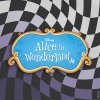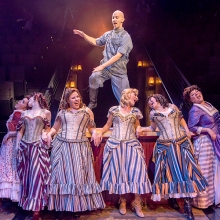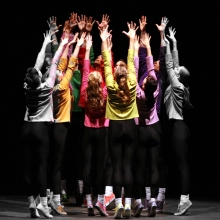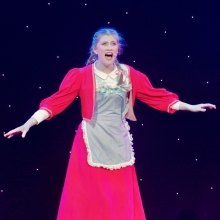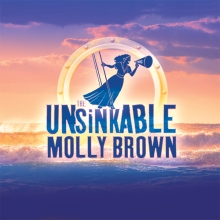Filichia Features: 1776 as a 2017 Musical

Filichia Features: 1776 as a 2017 Musical
“You’re going where for what?!?”
So asked many of my friends in voices filled with incredulity. But, yes, what I’d told them was true: I planned to go to Kenosha, Wisconsin to see a high-school production of 1776.
Some weren’t so surprised, because they know that the 1968-69 Tony-winner is one of my all-time favorite musicals. But a high-school production?
Yes. A lifetime of attending hundreds has taught me that the majority of them are astonishingly terrific.
(And I’ll bet many of you out there have learned the same thing.)
However, my love for 1776 and high-school productions aren’t the main reasons for my making a 1710-mile round-trip to The Badger State. The production that Cheri Steinkellner was mounting at Bradford High School wouldn’t be business-as-usual for the Peter Stone-Sherman Edwards hit.
Steinkellner had cast plenty of girls in roles usually reserved for the show’s many men. What’s more, some students of color would portray characters who had been, needless to say, lily-white in real life.
Dear readers, I’ll understand if your eyes are half-closed now, thinking, “Oh, big deal! She got the idea from Hamilton!” No – the real question is “Did Lin-Manuel Miranda get the idea from Steinkellner?”
I’m sure he didn’t, but the facts remain that nearly six years ago Steinkellner mounted a similar gender-bending production in Santa Barbara.
Give her daughter Emma a good deal of credit for it. When her mother was wondering what to direct next for UpStage Left Productions -- she’d already mounted the youth-centric Rent and Spelling Bee – the lass suggested 1776. Mom gently pointed out that a production would require only two girls – the ones who’d play Abigail Adams and Martha Jefferson – and a whopping 25 men. Not that many boys – but plenty of girls -- would turn out for auditions.
“Oh, why not just do it, anyway?” asked Emma in the guilelessness of youth. And that started her mother thinking that the other shows she’d staged had had adult characters played by kids, and everyone knew and accepted it. So if they were at home with high-schoolers who weren’t fooling anyone into believing they were older, why not have the same laissez-faire attitude toward gender?
Truth to tell, Emma had a secret agenda, for she wanted to play John Adams. Who can blame her? It’s a terrific role -- and may I interject to say that in the last 56 years in which I’ve seen at least 80% of all Broadway musicals – and many more in other places – William Daniels’ John Adams is still the best performance I’ve ever seen an actor give in a musical. Part of the reason why he flourished on stage, of course, is that he had so much superb material on the page.
Cheri agreed to direct a coed production, started casting and chose her daughter to play Ben Franklin.
(And yet, the two are still speaking.)
(By the way, if that name “Steinkellner” sounds familiar to you, the reason may be that she was one of the Tony-nominated writers for the book of Sister Act.)
The Santa Barbara production turned out so well that Steinkellner decided it was time to take the gender-blind casting to a new time zone. She knew that Holly Stanfield, the performing arts teacher at Bradford, had a much-acclaimed program called Kids Theatre Arts. Steinkellner went there to mount the show, but only after Stanfield, better acquainted with each student's ability, had cast the production.
This would not be the first time I saw those of the female sex doing 1776. Unlike Steinkellner – who had a male Adams, Franklin and Jefferson -- Sarah Crawford directed an all-female adult-cast version at Musical Theater Heritage in Kansas City in 2010.
Crawford, however, did it as a concert, with her cast positioned in front of music stands. In a black-box setting, every woman was dressed in contemporary black men’s clothes. I felt it worked perfectly well, but I did wonder if it would have been convincing or ludicrous if the women had been dressed in period costumes down to powdered wigs.
When I got to Kenosha and brought this up to Steinkellner, she waved off my concerns. “We didn’t quite costume them completely in period. We’re starting with a scene of contemporary kids visiting Independence Hall, and then having them imagine what happened there in 1776. They do put on a few clothes that suggest the era, but you won’t find a single powdered wig. What I think you’ll find happen is that after a scene or two, you’ll forget that you’re even watching girls in the male roles.”
Okay! I’ll go in with an open mind. And here’s hoping that you – and all my friends -- keep equally unbiased attitudes until next Friday when I report on the almost-all-female 1776 in Kenosha, Wisconsin.
You may e-mail Peter at pfilichia@aol.com. Check out his weekly column each Monday at www.broadwayselect.com and Tuesday at www.masterworksbroadway.com. His book, The Great Parade: Broadway’s Astonishing, Never-To-Be Forgotten 1963-1964 Season is now available at www.amazon.com.
Share
Callboard
-
Shake and shimmy it with the #Hairspray20Challenge! Join MTI and Broadway Media in celebrating 20 years of #Hairspray. Duet this here or find us on TikTok! Special thanks to @broadwaymedia and @jammyprod. Choreography Guides are a licensor official resource that provides step-by-step instruction from Broadway and professional choreographers for your productions! Visit @broadwaymedia to learn more. #mtishows #youcantstopthebeat #hairspraymusical #goodmorningbaltimore
View on Instagram









